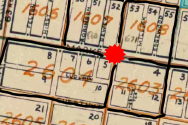The Sanborn maps available through the Library of Congress give us a pretty solid clue as to what the buildings in that area were in the 1950s - though the maps were originally drawn in the 1910s, very little changed between then and the 1950s. Unfortunately the map for this exact intersection is not available from the LOC online, I was able to get one from a mile east on Market street - they were pretty much all storefronts on the ground floor with dwelling units above and possibly behind. Garages would have been built with new construction only, this area was all rowhouses likely built before WWI. Businesses that were of high fire risk and/or occupying the ground floor with dwelling units above are notated - bakery, movie theater, hardware & paint store, etc.
It would have been extremely risky, suspicious, and physically difficult to transport a dead child to the other side of the city on mass transit, so I agree that they must have had a car, even though the "elevated railway" was just down the street. I think not having a garage to obscure neighbors' view makes it even more likely that Joseph was carried from the home to the car in the box - "Oh we're just taking this old bassinet to my sister's house, nothing to see here"
View attachment 389030

